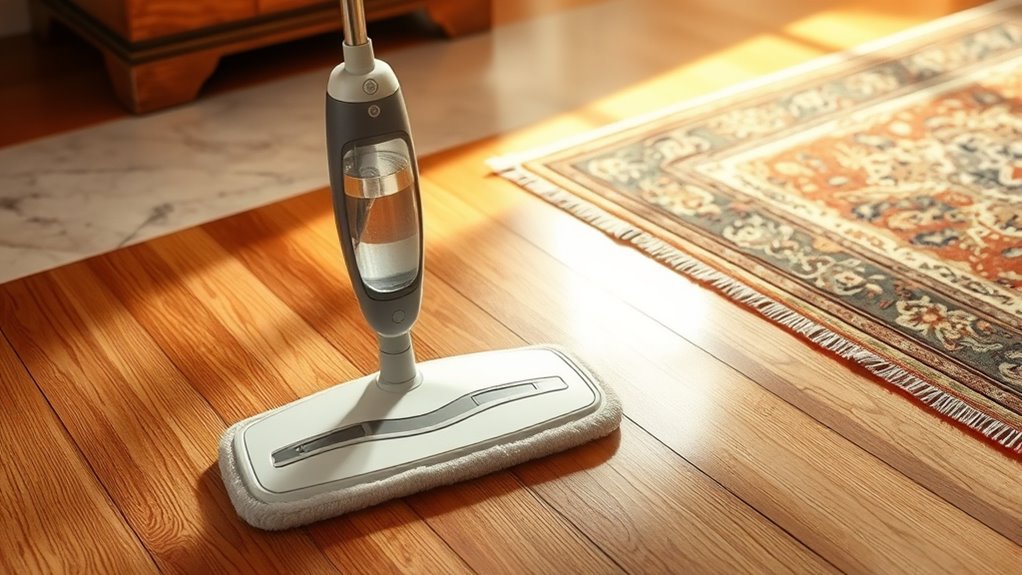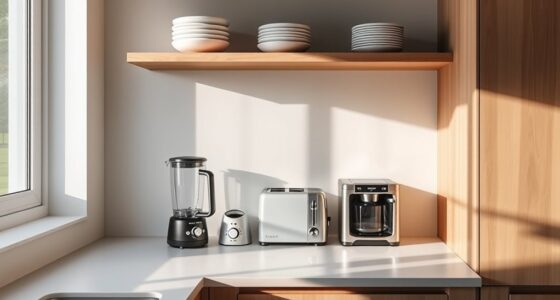You should avoid using a steam mop on unsealed or damaged hardwood floors, as excess moisture can cause warping or cracking. Don’t use it on porous surfaces like natural stone, unglazed ceramic tiles, or wallpaper because they can absorb moisture and get stained or peel. Be careful around electronics and electrical areas—steam can damage devices and pose safety risks. Also, avoid steaming vinyl or linoleum floors, which can warp or discolor with too much heat or moisture. Keep these tips in mind to protect your surfaces and discover more helpful advice ahead.
Key Takeaways
- Avoid using on unsealed or damaged hardwood floors to prevent warping or cracking from moisture.
- Do not steam clean upholstery or delicate fabrics, as moisture can cause mold or deterioration.
- Steer clear of porous surfaces like unglazed ceramic tiles, natural stone, or wallpaper, which can absorb moisture and stain.
- Never use steam mops on electronic devices, exposed wiring, or electrical outlets to prevent damage and safety hazards.
- Refrain from steam cleaning vinyl, linoleum, or similar flooring, as excessive moisture can cause warping or discoloration.

Steam mops are an effective way to clean and disinfect your floors, but knowing which surfaces are safe for steam cleaning is essential to prevent damage. Not all materials handle the high heat and moisture well, so it’s vital to understand where steam mops should and shouldn’t be used. For hardwood floor cleaning, you need to be especially cautious. While some hardwood floors can tolerate steam cleaning if they’re sealed and well-maintained, many are vulnerable to moisture damage. Excess steam can cause the wood to warp, swell, or crack over time. Before using a steam mop on hardwood, verify that your flooring is sealed properly. If unsure, it’s safer to opt for traditional cleaning methods like sweeping or damp mopping with a microfiber cloth. This approach helps preserve your hardwood’s finish without risking water damage.
Upholstery sanitizing is another area where you need to exercise caution. Some steam mops come with attachments designed for upholstery, but not all fabrics respond well to steam cleaning. Delicate or loosely woven textiles can retain moisture, leading to mold, mildew, or fabric deterioration. Before steaming upholstery, always check the manufacturer’s cleaning instructions. Testing a small, inconspicuous area first is a good idea to see how the fabric reacts. If a fabric appears to be sensitive, avoid steaming altogether. Instead, consider using a vacuum with a gentle upholstery attachment or specialized fabric cleaners to sanitize and refresh your furniture.
Certain surfaces are simply not suitable for steam mops due to their material makeup. For example, unsealed or porous surfaces, such as natural stone, unglazed ceramic tiles, or wallpaper, can absorb moisture, causing staining, discoloration, or peeling. Likewise, electronic devices, electrical outlets, or any area with exposed wiring should never be cleaned with a steam mop. The high heat and moisture pose a serious safety risk and can damage sensitive components. Additionally, vinyl or linoleum flooring might warp or discolor if exposed to excessive steam. When in doubt, consult the manufacturer’s guidelines for your specific surfaces before applying steam cleaning. Understanding the limitations of steam cleaning is essential for maintaining your surfaces and ensuring safety.
Frequently Asked Questions
Can Steam Mops Sanitize All Types of Upholstery?
Steam mops can’t sanitize all types of upholstery safely. For upholstery cleaning, you must consider fabric safety, as some materials may be damaged by heat and moisture. Always check the manufacturer’s instructions before using a steam mop on upholstery. While it can effectively remove dust and bacteria from certain fabrics, avoid using it on delicate or non-water-safe fabrics to prevent damage. Use proper upholstery cleaning methods tailored to the fabric type for best results.
Are Steam Mops Suitable for Cleaning Hardwood Floors With Finishes?
Did you know that nearly 80% of hardwood floor damage occurs from improper cleaning? Steam mops aren’t suitable for cleaning hardwood floors with finishes, as the high heat and moisture can cause damage or strip the finish. To protect your floors’ finish safety, avoid using steam mops on finished hardwoods. Instead, opt for a damp cloth or a cleaner specifically designed for delicate wood surfaces.
Should I Use a Steam Mop on Antique or Delicate Flooring?
You shouldn’t use a steam mop on antique flooring or delicate surfaces. The high heat and moisture can damage or warp these materials, causing irreversible harm. Instead, opt for gentle cleaning methods like a soft broom or a damp microfiber cloth. Protect your antique and delicate surfaces by avoiding steam mops, ensuring they stay in good condition for years to come.
Can Steam Cleaning Damage Sealed or Laminated Surfaces?
You might find sealed and laminated surfaces are best treated gently, as excessive steam can cause subtle issues over time. While these surfaces are designed for durability, the high heat and moisture from a steam mop could lead to slight warping or peeling if used too aggressively. It’s wise to test a small area first and keep the steam at a safe distance to avoid potential damage.
Is It Safe to Use a Steam Mop on Painted Walls?
Using a steam mop on painted walls isn’t recommended because the high heat and moisture can cause paint to peel or bubble. While steam mops are great for cleaning many surfaces, painted walls are sensitive to water and heat. If you want to clean your walls, opt for a damp cloth or gentle cleaning method instead. This will help maintain your paint’s integrity and keep your walls looking fresh.
Conclusion
Remember, using your steam mop on the wrong surfaces is like walking on thin ice—you risk damage or warping. Always double-check if your surface is safe for steam cleaning before you start. When in doubt, opt for other cleaning methods to protect your floors and belongings. By being cautious, you’ll keep your home sparkling and damage-free, just like a well-tended garden that flourishes with the right care. Stay safe and clean!









